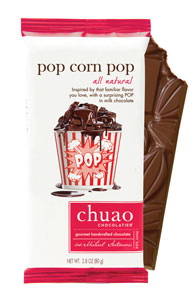McCormick grilling trends; Creative confectioners; Inulin in reduced sugar cookies
NEWS
 McCormick releases trends for grilling
McCormick releases trends for grillingWith the summer season well under way, many people are turning to their grill to help prepare a number of different meat, poultry, fish, and vegetable dishes. McCormick & Co. presents several flavor and product trends in its McCormick® Grill Mates® & Lawry’s® Flavor Forecast® 2013: Grilling Edition report to inspire consumers to bring their grilled foods to the next level.
Of particular interest to product developers, culinary professionals, and adventurous home cooks are the top seven flavors growing in popularity in recipes for grilled foods. Sweet tea is used in marinades and sauces, and smoked tomatoes have a more intense, rich tomato flavor perfect for pizza, salads, and sandwiches. The smoke and spice notes of whiskey harmonize well with strong sauces and marinades used for slow and low grilling, and the warm, spicy bite of ginger lends an Asian cuisine touch to spice rubs, marinades, and fruit. Grilling brings out the sweet flavor of white peach used in salads, salsas, and beverages, or served sliced alongside the grilled main course, and aromatic oregano brings a Mediterranean flare to any grilled dish. The final flavor is not one from food, rather it is the sweet, nutty flavor that pecan wood imparts to food grilled over it.
One of the grilled food trends highlighted in the report suggests grilling fruit and adding it to beverages like lemonade, iced tea, and sangria. Grilling fruits like apricots, mangoes, pineapple, peaches, watermelon, papaya, and more generates a smoky flavor and helps heighten the sweet flavors of the fruits.
 Confectioners get creative
Confectioners get creative
Willy Wonka’s chocolate factory. Well, it is no comparison to the vast array of confections and snacks showcased at the National Confectioners Association’s 2013 Sweets and Snacks Expo.
The event, held May 21–23 in Chicago, brought together more than 600 companies that showcased a number of innovative and imaginative products as well as some tried and true favorites. Among the more noteworthy trends was flavor variety. Product developers seem to be pushing the envelope when it comes to the flavor of sweets and snacks. Of course the traditional favorite flavors were represented, like strawberry and grape for some confections and sour cream and onion and barbecue for snacks. But how about Tabasco-flavored Jelly Belly Jelly Beans from Jelly Belly Candy Co., Chile Picante Poplets from Rocky Mountain Popcorn, and D’Anjou Pear and Cinnamon, Pink Grapefruit, and Tupelo Honey Organic Hard Candy from Torie and Howard as examples of taking confections and savory snacks to new levels?
Interesting uses of flavorings and ingredients are especially evident in the chocolate confections category, where chocolate is combined with such ingredients as chili peppers, potato chips, honey, lavender, herbs, teas, floral, and more. For example, Chuao Chocolatier, San Diego, Calif., debuted its Pop Corn Pop chocolate bar, a blend of milk chocolate, puffed whole grains, toasted corn chips, sea salt, and popping candy. Manufacturers like Chuao are also introducing new twists on classic flavor combinations. Its Orange-A-Go-Go chocolate bar combines dark chocolate with caramelized orange peel and orange bergamot.
Inulin’s use in reduced-sugar cookies
Sugar plays a number of important functional roles in baked goods, but its overconsumption is implicated as a contributing factor to the increases of overweight and obesity. Researchers are investigating ways to successfully replace some of the sugar in baked goods, and are finding that inulin may help product developers reduce the amount of sugar in baked goods.
A study published in Journal of Food Science concludes that inulin could be used to replace up to 25% of sugar in cookie dough without having significant effects on consumer perception. The results of replacing 25% and 50% of sugar with erythritol and inulin showed that using erythritol and inulin to replace sugar affected the cookie’s matrix and appearance, but using inulin at a 25% replacement produced cookies that were the closest to the control. The researchers also learned that the cookie dough formulated with erythritol was suitable for processing but produced cookies that were hard and tough.
Read more about the study, “Inulin and Erythritol as Sucrose Replacers in Short-dough Cookies: Sensory, Fracture, and Acoustic Properties,” in the May 2013 issue of Journal of Food Science.
What’s new with food companies
• Avure Technologies food division will open a new facility in Middletown, Ohio, in late 2013.
• Biothera has named Shanghai Toong Yeuan Food Technology Co. as distributor of its ingredients in China.
• Dow AgroSciences has opened an R&D facility at its global headquarters in Indianapolis, Ind.
• DSM and Sugar Creek Foods will develop a new live and probiotic frozen yogurt range of products.
• DSM Food Specialties’ savory ingredients facilities in the Netherlands and China have received FSSC 22000 food safety certification.
• DuPont has combined its Danisco, Solae, and Qualicon units into one business called DuPont Nutrition & Health.
• Harvest Granola LLC has acquired Olympia Granola.
• Kalsec has named Connell Brothers Co. as distributor of its products to the India and Bangladesh markets. It also has opened the Henry Todd Finishing Center in Kalamazoo, Mich.
• Shuanghui International has acquired Smithfield Foods.
• Solabia Group has begun offering its peptones in the United States through its subsidiary Solabia Inc.
• Symrise has opened a research center at its headquarters in Holzminden, Germany.
• Thermo Fisher Scientific will acquire Life Technologies Corp.
 Karen Nachay,
Karen Nachay,
Associate Editor
[email protected]
